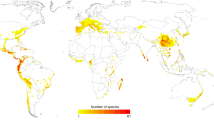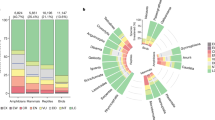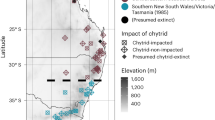Abstract
Amphibian population declines far exceed those of other vertebrate groups, with 30% of all species listed as threatened by the International Union for Conservation of Nature1,2,3. The causes of these declines are a matter of continued research, but probably include climate change, land-use change and spread of the pathogenic fungal disease chytridiomycosis1,4,5. Here we assess the spatial distribution and interactions of these primary threats in relation to the global distribution of amphibian species. We show that the greatest proportions of species negatively affected by climate change are projected to be found in Africa, parts of northern South America and the Andes. Regions with the highest projected impact of land-use and climate change coincide, but there is little spatial overlap with regions highly threatened by the fungal disease. Overall, the areas harbouring the richest amphibian faunas are disproportionately more affected by one or multiple threat factors than areas with low richness. Amphibian declines are likely to accelerate in the twenty-first century, because multiple drivers of extinction could jeopardize their populations more than previous, mono-causal, assessments have suggested.
This is a preview of subscription content, access via your institution
Access options
Subscribe to this journal
Receive 51 print issues and online access
$199.00 per year
only $3.90 per issue
Buy this article
- Purchase on Springer Link
- Instant access to full article PDF
Prices may be subject to local taxes which are calculated during checkout




Similar content being viewed by others
References
Stuart, S. N. et al. Status and trends of amphibian declines and extinctions worldwide. Science 306, 1783–1786 (2004)
IUCN. An Analysis of Amphibians on the 2008 IUCN Red List 〈http://www.iucnredlist.org/initiatives/amphibians〉 (2008)
Wake, D. B. & Vredenburg, V. T. Are we in the midst of the sixth mass extinction? A view from the world of amphibians. Proc. Natl Acad. Sci. USA 105, 11466–11473 (2008)
Blaustein, A. R. & Kiesecker, J. M. Complexity in conservation: lessons from the global decline of amphibian populations. Ecol. Lett. 5, 597–608 (2002)
Beebee, T. J. C. & Griffiths, R. A. The amphibian decline crisis: a watershed for conservation biology? Biol. Conserv. 125, 271–285 (2005)
Houlahan, J. E., Findlay, C. S., Schmidt, B. R., Meyer, A. H. & Kuzmin, S. L. Quantitative evidence for global amphibian population declines. Nature 404, 752–755 (2000)
Becker, C. G., Fonseca, C. R., Haddad, C. F. B., Batista, R. F. & Prado, P. I. Habitat split and the global decline of amphibians. Science 318, 1775–1777 (2007)
Bosch, J., Carrascal, L. M., Duran, L., Walker, S. & Fisher, M. C. Climate change and outbreaks of amphibian chytridiomycosis in a montane area of Central Spain; is there a link? Proc. R. Soc. Lond. B 274, 253–260 (2007)
Pounds, J. A. et al. Widespread amphibian extinctions from epidemic disease driven by global warming. Nature 439, 161–167 (2006)
Lips, K. R., Diffendorfer, J., Mendelson, J. R. & Sears, M. W. Riding the wave: reconciling the roles of disease and climate change in amphibian declines. PLoS Biol. 6, e72 (2008)
Lawler, J. J., Shafer, S. L. & Blaustein, A. R. Projected climate impacts for the amphibians of the Western Hemisphere. Conserv. Biol. 24, 38–50 (2010)
Araújo, M. B., Thuiller, W. & Pearson, R. G. Climate warming and the decline of amphibians and reptiles in Europe. J. Biogeogr. 33, 1712–1728 (2006)
Bielby, J., Cooper, N., Cunningham, A. A., Garner, T. W. J. & Purvis, A. Predicting susceptibility to future declines in the world’s frogs. Conservation Letters 1, 82–90 (2008)
Sodhi, N. S. et al. Measuring the meltdown: drivers of global amphibian extinction and decline. PLoS One 3, e1636 (2008)
Becker, C. G. & Zamudio, K. R. Tropical amphibian populations experience higher disease risk in natural habitats. Proc. Natl Acad. Sci. USA 108, 9893–9898 (2011)
Rohr, J. R., Raffel, T. R., Romansic, J. M., McCallum, H. & Hudson, P. J. Evaluating the links between climate, disease spread, and amphibian declines. Proc. Natl Acad. Sci. USA 105, 17436–17441 (2008)
Rödder, D., Kielgast, J. & Lötters, S. Future potential distribution of the emerging amphibian chytrid fungus under anthropogenic climate change. Dis. Aquat. Organ. 92, 201–207 (2010)
van Vuuren, D. P., Sala, O. E. & Pereira, H. M. The future of vascular plant diversity under four global scenarios. Ecol. Soc. 11, 25 (2006)
Alcamo, J. et al. Global Change Scenarios of the 21st Century, Results from the IMAGE 2.1 Model 3–96 (Elsevier, 1998)
Millennium Ecosystem Assessment. Ecosystems and Human Well-Being: Scenarios. (Island, 2005)
Daszak, P., Cunningham, A. A. & Hyatt, A. D. Infectious disease and amphibian population declines. Divers. Distrib. 9, 141–150 (2003)
Kilpatrick, A. M., Briggs, C. J. & Daszak, P. The ecology and impact of chytridiomycosis: an emerging disease of amphibians. Trends Ecol. Evol. 25, 109–118 (2010)
Hof, C., Rahbek, C. & Araújo, M. B. Phylogenetic signals in the climatic niches of the world’s amphibians. Ecography 33, 242–250 (2010)
Hof, C., Levinsky, I., Araújo, M. B. & Rahbek, R. Rethinking species’ ability to cope with rapid climate change. Glob. Change Biol. 17, 2987–2990 (2011)
Ashcroft, M. B. Identifying refugia from climate change. J. Biogeogr. 37, 1407–1413 (2010)
Phillimore, A. B., Hadfield, J. D., Jones, O. R. & Smithers, R. J. Differences in spawning date between populations of common frog reveal local adaptation. Proc. Natl Acad. Sci. USA 107, 8292–8297 (2010)
Jetz, W., Wilcove, D. S. & Dobson, A. P. Projected impacts of climate and land-use change on the global diversity of birds. PLoS Biol. 5, e157 (2007)
Beaumont, L. J. et al. Impacts of climate change on the world’s most exceptional ecoregions. Proc. Natl Acad. Sci. USA 108, 2306–2311 (2011)
Araújo, M. B. & New, M. Ensemble forecasting of species distributions. Trends Ecol. Evol. 22, 42–47 (2007)
Meehl, G. A. et al. The WCRP CMIP3 multimodel dataset: a new era in climate change research. Bull. Am. Meteorol. Soc. 88, 1383–1394 (2007)
IUCN. Global Amphibian Assessment 〈http://www.iucnredlist.org/initiatives/amphibians/〉 (2004)
IPCC. Special Report on Emissions Scenarios, Prepared for the Third Assessment Report (IPCC, 2000)
IPCC. Contribution of Working Group I to the Fourth Assessment Report of the Intergovernmental Panel on Climate Change: Summary for Policymakers (IPCC, 2007)
Carey, C. & Alexander, M. A. Climate change and amphibian declines: is there a link? Divers. Distrib. 9, 111–121 (2003)
Araújo, M. B. et al. Quaternary climate changes explain diversity among reptiles and amphibians. Ecography 31, 8–15 (2008)
Hurlbert, A. H. & Jetz, W. Species richness, hotspots, and the scale dependence of range maps in ecology and conservation. Proc. Natl Acad. Sci. USA 104, 13384–13389 (2007)
Millennium Ecosystem Assessment. Ecosystems and Human Well-Being: Synthesis (Island, 2005)
Farber, O. & Kadmon, R. Assessment of alternative approaches for bioclimatic modeling with special emphasis on the Mahalanobis distance. Ecol. Modell. 160, 115–130 (2003)
Bioensembles:. software for computer intensive ensemble forecasting of species distributions under climate change v. 1.0 (privately distributed, Madrid, Goiás, Évora, 2009)
Phillips, S. J., Anderson, R. P. & Schapire, R. E. Maximum entropy modeling of species geographic distributions. Ecol. Modell. 190, 231–259 (2006)
Phillips, S. J. & Dudik, M. Modeling of species distributions with Maxent: new extensions and a comprehensive evaluation. Ecography 31, 161–175 (2008)
Araújo, M. B., Pearson, R. G., Thuiller, W. & Erhard, M. Validation of species–climate impact models under climate change. Glob. Change Biol. 11, 1504–1513 (2005)
Smith, M. A. & Green, D. M. Dispersal and the metapopulation paradigm in amphibian ecology and conservation: are all amphibian populations metapopulations? Ecography 28, 110–128 (2005)
Stockwell, D. R. B. & Peterson, A. T. Effects of sample size on accuracy of species distribution models. Ecol. Modell. 148, 1–13 (2002)
McPherson, J. M., Jetz, W. & Rogers, D. J. The effects of species’ range sizes on the accuracy of distribution models: ecological phenomenon or statistical artefact? J. Appl. Ecol. 41, 811–823 (2004)
Wisz, M. S. et al. Effects of sample size on the performance of species distribution models. Divers. Distrib. 14, 763–773 (2008)
Nenzén, H. K. & Araújo, M. B. Choice of threshold alters projections of species range shifts under climate change. Ecol. Modell. 222, 3346–3354 (2011)
Araújo, M. B., Alagador, D., Cabeza, M., Nogues-Bravo, D. & Thuiller, W. Climate change threatens European conservation areas. Ecol. Lett. 14, 484–492 (2011)
Araújo, M. B., Whittaker, R. J., Ladle, R. J. & Erhard, M. Reducing uncertainty in projections of extinction risk from climate change. Glob. Ecol. Biogeogr. 14, 529–538 (2005)
Pearson, R. G. et al. Model-based uncertainty in species range prediction. J. Biogeogr. 33, 1704–1711 (2006)
Diniz-Filho, J. A. F. et al. Partitioning and mapping uncertainties in ensembles of forecasts of species turnover under climate change. Ecography 32, 897–906 (2009)
Acknowledgements
We are grateful to D. Rödder, S. Lötters and J. Kielgast for the provision of data and B. dendrobatidis modelling results. We thank C. Graham, R. Colwell, N. Sanders, H. H. Bruun and S. Fritz for comments on previous versions of the manuscript. Special thanks to T. Rangel for technical and statistical support. C.H., M.B.A. and C.R. acknowledge the Danish National Research Foundation for support to the Center for Macroecology, Evolution and Climate; research by M.B.A. was funded by the Portuguese Foundation for Science and Technology (PTDC/AAC-AMB/98163/2008); W.J. acknowledges support from NSF grants DBI 0960550 and DEB 1026764.
Author information
Authors and Affiliations
Contributions
C.H., M.B.A. and C.R. designed the study, C.H. performed all analyses, all authors discussed the results. C.H. wrote the paper, with substantial contributions from all authors.
Corresponding author
Ethics declarations
Competing interests
The authors declare no competing financial interests.
Supplementary information
Supplementary Information
The file contains Supplementary Methods, Supplementary Discussion, Supplementary Tables 1-2, Supplementary Figures 1-14 with legends and additional references. (PDF 8972 kb)
Rights and permissions
About this article
Cite this article
Hof, C., Araújo, M., Jetz, W. et al. Additive threats from pathogens, climate and land-use change for global amphibian diversity. Nature 480, 516–519 (2011). https://doi.org/10.1038/nature10650
Received:
Accepted:
Published:
Issue Date:
DOI: https://doi.org/10.1038/nature10650
This article is cited by
-
New insights into avian malaria infections in New Zealand seabirds
Parasitology Research (2024)
-
Metabolites of Xenorhabdus bacteria are potent candidates for mitigating amphibian chytridiomycosis
AMB Express (2023)
-
Effects of urban land-use types on avifauna assemblage in a rapidly developing urban settlement in Ghana
Urban Ecosystems (2023)
-
Multi-Spatial-Scale Factors Determining the Abundance of Frogs in Rice Paddy Fields and Their Potential as Biological Control Agents
Wetlands (2023)
-
An efficient environmental DNA detection method for rare species: a case study of a small salamander (Hynobius boulengeri)
Analytical Sciences (2023)
Comments
By submitting a comment you agree to abide by our Terms and Community Guidelines. If you find something abusive or that does not comply with our terms or guidelines please flag it as inappropriate.



